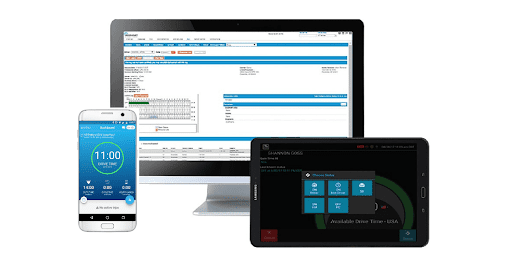The Federal Motor Carrier Safety Administration (FMCSA) has an audit requirement to ensure that new trucking companies that cross state lines follow the same set of safety standards. This new entrant safety audit is required for all new companies within their first 12 months of operation.
If you’re looking to start your transportation business, you’ll want to ensure you know the pertinent details of how the DOT new entrant safety audit works and how you can prepare.
How does the new entrant safety audit work?
The FMCSA New Entrant Safety Audit applies to both U.S. and Canadian based motor carriers. As a new entrant into the trucking industry, you must follow regulations set forth by the Department of Transportation (DOT), including following their detailed record keeping and safety processes.
The new entrant audit is done between the first six and twelve months of being in operation. The FMCSA safety audit includes seven Behavior and Safety categories that determine your compliance.
The key to compliance? Documentation! Be sure to keep detailed records from the day you begin ideating your business throughout the entirety of your operation.
What is new entrant status?
A new entrant status is required for carriers that are looking to operate in interstate commerce. You are required to complete the form MCS-150, which is the Combined Motor Carrier Identification Report.
After you’ve completed that, you must then complete the proper form in the OP-1 series. This is required of any new motor carrier, that is not domiciled in Mexico, applying for a DOT identification number.
During your new entrant period, you’ll be monitored for your first 18 months. During this time the FMCSA will conduct a safety audit, monitor your safety performance through roadside inspections, and if safe, grant permanent authority to operate.
What is needed for DOT safety audit?
Throughout the DOT Safety Audit process, they will assess your safety by collecting data through these sources:
Safety audits
This will be done at your place of business or offsite to ensure that you have the basic management controls in place.
Roadside inspections
Carried out by certified inspectors at checkpoints or weigh stations, inspections will ensure that you’re in compliance with regulations.
Investigations
At your place of business or offsite, FMCSA will help you identify why safety problems are happening and provide recommendations for corrective action.
Crash reports
In the event of a crash, the reports will be completed by State or local law enforcement. FMCSA will utilize this data.
Ensure that you keep all your records for everything, including your security plan, records of inspections, and other pertinent paperwork to make the process as smooth as possible.
How long does a DOT audit take?
The DOT audit process is not a quick one. It can take three to six months. The reason for this extended timeline is to ensure that you’re properly complying with all safety requirements over an extended period.
What triggers a DOT audit?
A DOT audit is bound to happen for all motor carriers. It’s not a matter of “if” but a matter of “when”. In the New Entrant Safety Audit, the DOT will measure your compliance through an audit because you’re a new motor carrier.
However, that doesn’t mean you’re off the hook for DOT audits after it’s complete. Any time after a poor roadside inspection or an accident, you will likely be audited by the DOT.
What happens if you fail a DOT audit?
If you fail your FMCSA audit, they will provide you with written notice detailing the violations that caused the failure. They’ll also provide you with the requirements needed to have a corrective action plan.
You will need to agree with the action plan in writing, or your registration will be revoked and your operation will be placed out of service. It’s important to note that the corrective action plan is very extensive and is imperative to complete your safety rating.
They take an intense amount of work to complete and can be complicated, so it’s best to do the DOT audit right the first time if possible.
How to prepare for the new entrant safety audit
Now that you’re aware of how complicated it becomes if you don’t pass your New Entrant Safety Audit, there’s a list of things you should do to get prepared to ensure you pass. Follow the guide below.
Drug and alcohol evaluation
During the audit the DOT will ensure that you’re following all of the outlined drug and alcohol rules. You will need to ensure that you have a DOT-approved system in place.
Ask yourself the following questions to make sure you’re in compliance:
- Do you have a system in place for drug and alcohol testing?
- Do you have a random drug and alcohol testing program?
- Do you have any drivers who have refused a drug or alcohol test? If so, this will cause you to fail your safety audit.
- Do you have any drivers that have had a blood alcohol content of 0.04 or higher? If so, this will also cause you to fail your safety audit.
- Do you have any drivers who have failed to complete proper follow-up procedures if they have tested positive for drugs? Again, this will cause a failure to your safety audit.
Keep very detailed reports of your processes and the outcomes of each test, along with any corrective actions taken.
Driver violations
You will also need to have detailed records for each driver. This includes ensuring that all your drivers are qualified, both educationally and medically.
It’s also important that they hold the proper active CDLs for the vehicles that they’re handling. If you do not have the proper records, you’ll receive driver violations that will automatically fail your safety audit.
Operation violations
Operating a trucking company requires more than just proper drivers licenses and DOT licensing. There are legal requirements you must also follow to ensure that your trucking operation is operating safely.
Consider the following:
- Do you have the right insurance in place?
- Do you have a way to keep track of your hours of service records?
- Are you compliant with the electronic logging device (ELD) mandate?
While this may be redundant, it’s important to note that if you do not have these in place and the documentation to prove it, you will fail your audit.
Repairs and inspections violations
Another highly important piece to have a properly functioning transportation company is that all your equipment stays in compliance. That means you’ll have to properly maintain your equipment to pass inspections.
You must also keep your drivers and other people on the road safe. To stay in compliance, make sure that you are not doing any of the following:
- Operating vehicles declared out-of-service for safety deficiencies
- Operating vehicles before appropriate repairs are made
- Not performing repairs that are reported in the driver-vehicle inspection reports
- Operating a vehicle that is not periodically inspected
If you fail any of these violations, you’ll also fail your audit.
Documentation is the best way to prepare for a DOT audit
During your DOT audit, you’ll work with an official auditor and be required to submit all the appropriate documentation to the FMCSA. To ensure that the process is as smooth as possible, ensuring that your record keeping processes are in top condition will be the best way to ensure you pass.
Gather all the required documentation before the audit, make sure it’s easily accessible and identifiable and shows that your company is properly following all regulations that are set forth by the FMCSA. If so, you should have a smooth auditing process.
FAQ
The FMCSA will send you a safety audit passed letter stating you comply with regulations if you passed, or a failed letter with steps to take if you did not pass.
If you pass the new entrant audit, you will continue normal operations, but if you fail, you may be required to have your trucks and buses inspected every time they are dispatched until compliance improves.
The three key components of a safety audit are reviewing your safety management systems, analyzing past crash data, and inspecting drivers’ hours of service compliance through examination of RODS.


